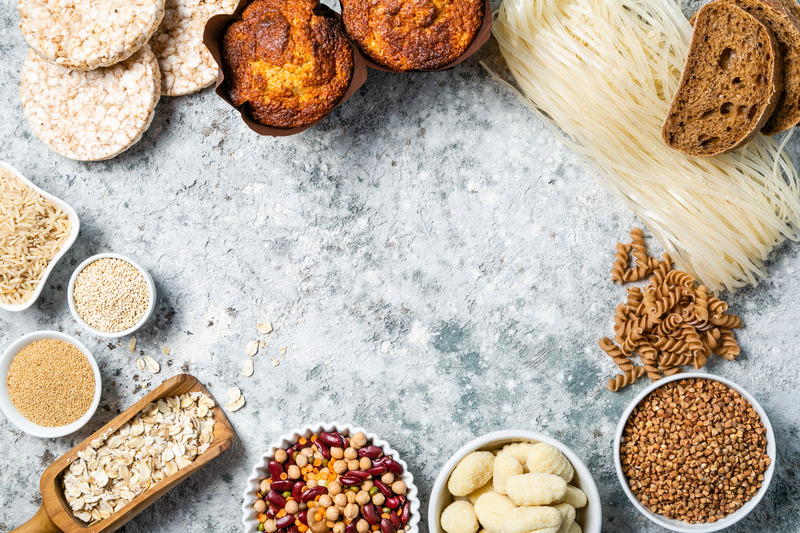[Article updated on 19/09/2023]
What is gluten?
It is a sticky substance composed of proteins and contained in the following cereals: wheat, barley, rye, kamut, spelt, einkorn. Although it does not contain gluten, oats should also be avoided in a gluten-free diet due to cross-contamination problems. This is why you can sometimes find gluten-free oats in stores.
What is gluten used for?
Gluten is formed on contact with water while kneading the dough. This is what gives elasticity and strength to the dough and allows it to rise. It gives it an airy and soft texture. It is for this reason that it is particularly interesting for making bread and various pastries.
It is also widely used by the food industry as a binding or texturing agent in cold meats and prepared meals, for example.
When should I cut out gluten?
The only situation that requires cutting out gluten completely is if you have Celiac disease.
This is an autoimmune disease which is triggered by taking gluten and where the intestinal microvilli are destroyed.
Most of the symptoms of this disease are digestive symptoms: diarrhea, abdominal pain, nausea, etc.
Weight loss and/or growth retardation may also be observed.
Other symptoms that may be present include:
- Iron deficiency anemia
- Prolonged fatigue
- Osteoporosis…
If you have these types of symptoms, it is therefore important that you make an appointment with your general practitioner or a gastroenterologist so that they can prescribe the necessary tests.
Indeed, screening for Celiac disease is done by a blood test and a biopsy of the small intestine.
Attention ! If you need to have a blood test and/or colonoscopy to rule out or confirm celiac disease, do not remove gluten from your diet as this will distort the diagnosis!
In the context of Celiac disease, the only treatment is the avoidance of gluten, even in trace form.

What if I don’t have celiac disease?
If you do not have symptoms when consuming products containing gluten: bread, pasta, semolina, rusks… then there is no need to eliminate it.
If you feel like you are suffering from more bloating, transit problems, stomach aches after consuming gluten, here are some tips:
- First of all, try to consume less and less often. These problems may be due to the amount you consume.
- Eat more slowly and chew well.
- Try to vary the sources of starchy foods to consume fewer products containing wheat. For example, by integrating legumes (lentils, chickpeas, red beans, etc.), potatoes, rice, quinoa, buckwheat, millet. All of these starchy foods are also high in complex carbohydrates and contain no gluten.
- Choose whole and semi-complete cereals rather than white cereals.
- Avoid industrial biscuits, sandwich bread, etc. which contain gluten but also other additives that can disrupt your digestion.
If despite this, you still suffer from digestive problems, perhaps you suffer from hypersensitivity to non-Celiac gluten. However, to date there is no clearly established scientific explanation for these symptoms and the existence of this hypersensitivity is widely controversial.
What if it was something other than gluten?
Wheat, barley, rye, kamut, spelt and einkorn are cereals which, in addition to containing gluten, are rich in fructans.
However, fructans are part of FODMAPs.
FODMAP is an English acronym which stands for Fermentable Oligosaccharides Disaccharides Monosaccharides And Polyols. These are short-chain carbohydrates present in certain foods which are little or not absorbed in the small intestine and which are used as nutrients for our flora once they arrive in the colon.
In some people, they can cause intestinal problems such as intestinal pain, bloating, transit disorders.
So, if you suffer from digestive problems by consuming gluten but also other foods such as liquid or semi-liquid dairy products (milk, cottage cheese, cream, etc.), legumes, stone fruits or even garlic and onion. Maybe it’s better to explore FODMAPs than gluten.
How to avoid gluten?
- Favor homemade products rather than ultra-processed industrial products.
- If you buy industrial products, read the label list to see if it contains gluten. In fact, manufacturers are required to indicate the presence of gluten in the list of ingredients.
Additionally, the logo proves that the product is certified gluten-free.
- Some ideas to replace bread: rice, corn, buckwheat pancakes, buckwheat, chestnut rusks…
- To replace wheat flour pasta, you can find gluten-free pasta in stores.
- To replace wheat flour, you can use various gluten-free flours: rice flour, chestnut flour, corn flour, arrowroot flour, millet flour, buckwheat flour, etc.
A word of advice: to make your preparations, it is better to mix the flours. You can also find ready-made flour mixes on the market depending on what you want to make (bread, cakes, etc.).
My gluten-free bread recipe
Ingredients :
250 g of buckwheat flour, 250 g of rice flour, baking powder (look on the packet for the quantity needed in relation to the quantity of flour), 1 pinch of salt, 5 teaspoons of oil, 500 mL of barely lukewarm water (to obtain a soft, non-liquid paste);
Preparation :
- Preheat the oven to 180°C.
- Mix all the ingredients except the water.
- Add the water little by little, mixing well each time until you obtain a soft but not liquid dough (sometimes you need to add a little more than 500 mL because some rice and buckwheat flours absorb more water than others).
- Take a silicone cake mold or line it with baking paper.
- Place the dough in the cake mold.
- Cook for 1h30-1h45, checking the cooking by inserting your knife.
